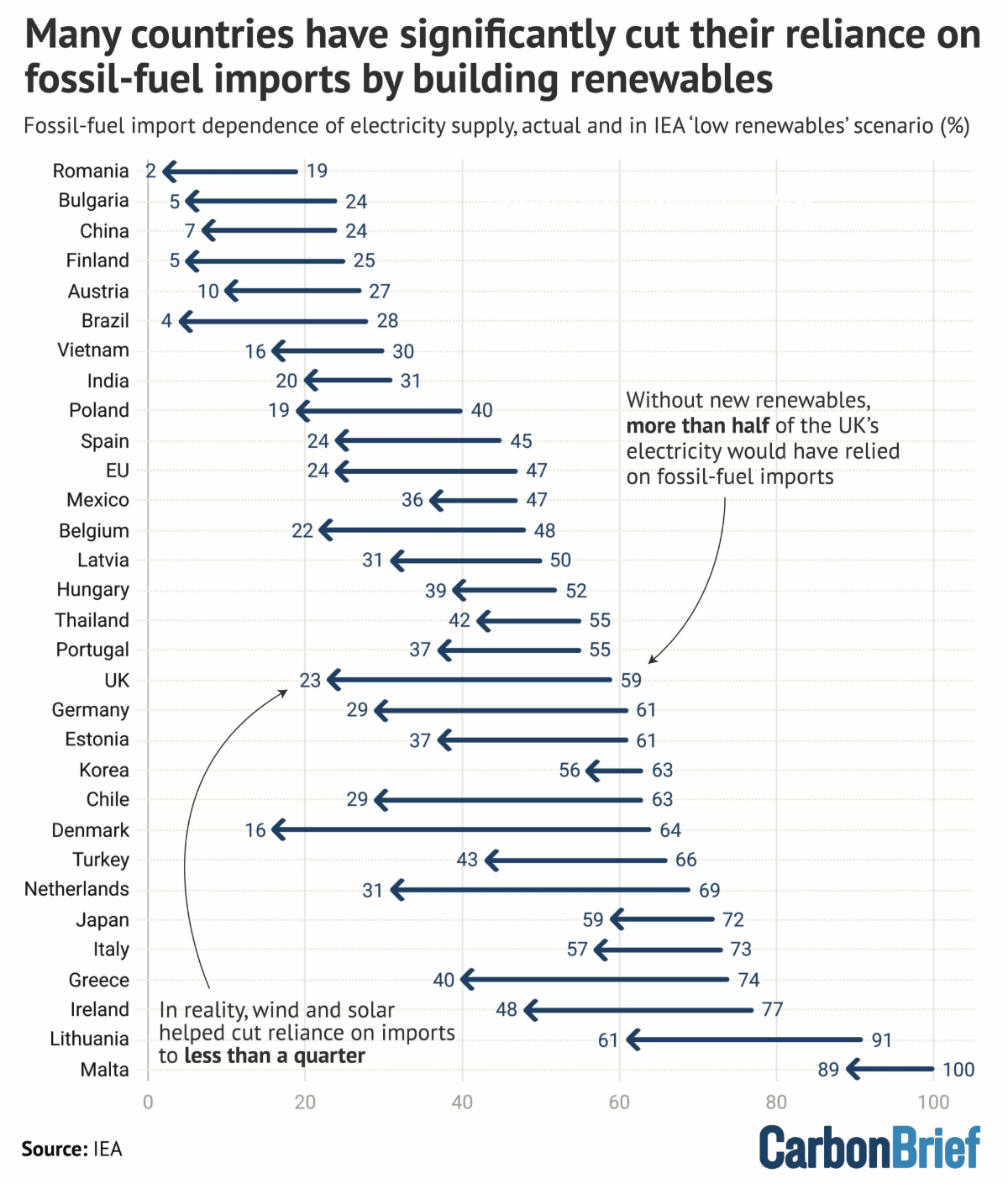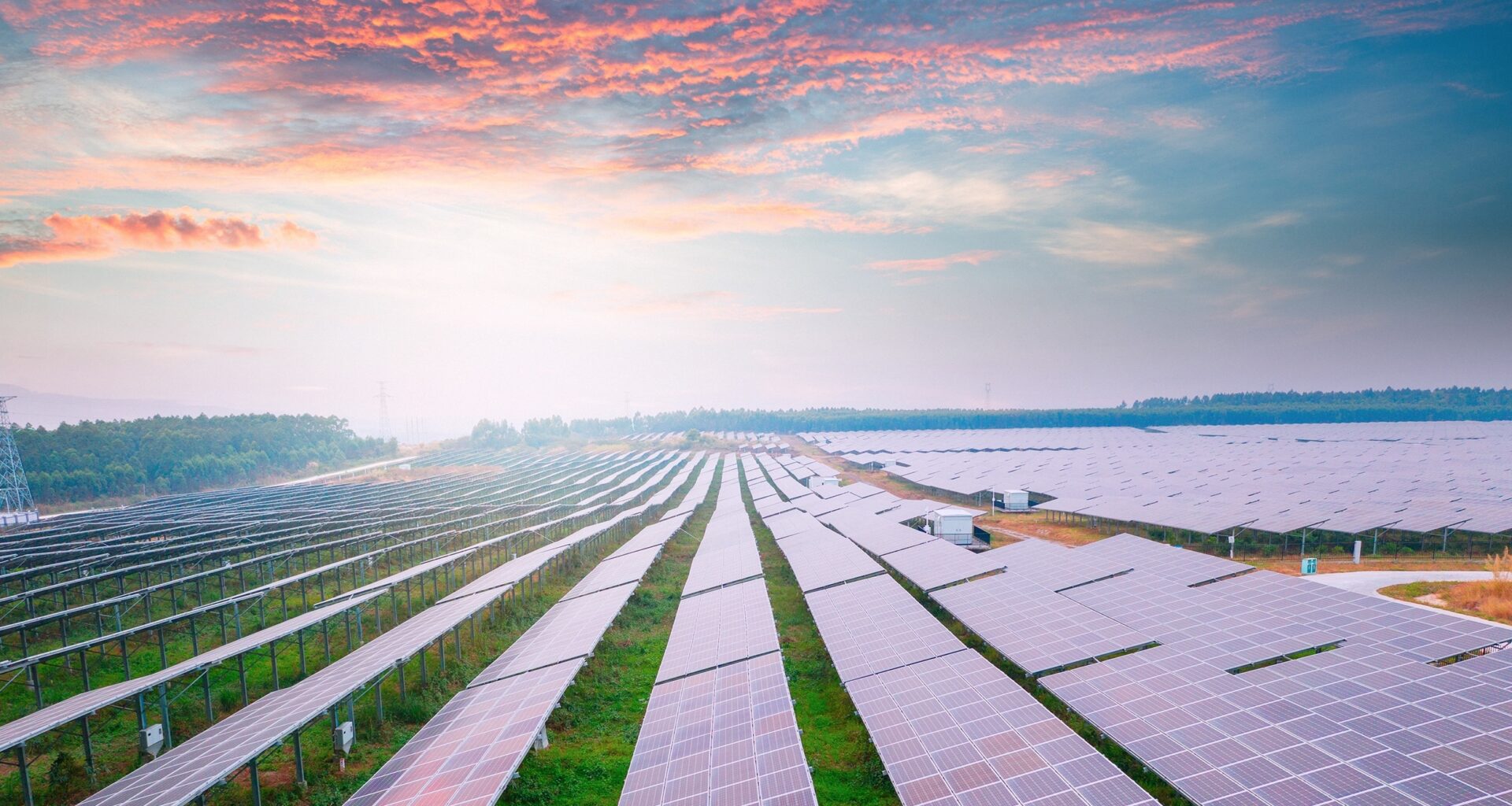Support CleanTechnica’s work through a Substack subscription or on Stripe.
In the executive summary to its annual renewable energy report, the International Energy Agency (IEA) said, “Global renewable power capacity is expected to double between now and 2030, increasing by 4,600 gigawatts. This is roughly the equivalent of adding China, the European Union, and Japan’s power generation capacity combined to the global energy mix. Solar PV accounts for almost 80 percent of the global increase, followed by wind, hydropower, bioenergy, and geothermal.
“In more than 80 percent of countries worldwide, renewable power capacity is set to grow faster between 2025 and 2030 than it did over the previous five year period. However, challenges including grid integration, supply chain vulnerabilities, and financing are also increasing.” You can download the full report at this link.
Carbon Brief has taken the data supplied by the IEA and converted it into a chart that illustrates the changes.

The 2025 Renewables report shows that more than 100 countries have cut their dependence on fossil fuel imports and saved hundreds of billions of dollars by continuing to invest in renewables. This is despite the global full court press in favor of expanding the use of fossil fuels from the US being conducted by the current US administration.
The UK, Germany, and Chile have reduced their need for imported coal and gas by around a third since 2010, mainly by building wind and solar power. Denmark has cut its reliance on fossil fuel imports by nearly half over the same period. Renewable expansion allowed these nations to collectively avoid importing 700 million tons of coal and 400 billion cubic meters of methane in 2023, which is equivalent to about 10 percent of global consumption.
In doing so, the fuel importing countries saved more than $1.3 trillion between 2010 and 2023 that would otherwise have been spent on imported fossil fuels. The Renewables 2025 report compares recent trends in renewable expansion to an alternative “low renewable-energy source” scenario in which the increase in local renewable energy did not take place. Roughly 80% of this new renewable capacity was built in nations that rely on coal and gas imports to generate electricity.
In total, the IEA identified 107 countries that had reduced their dependence on fossil fuel imports for electricity generation because of their transition to renewables other than hydropower. 38 cut their reliance on electricity from imported coal and gas by more than 10 percentage points and eight had seen that share drop by more than 30 percentage points.
In its report, the IEA stressed that renewables “inherently strengthen energy supply security,” because they generate electricity domestically, while also “improving…economic resilience” in those countries. The effect is seen most strongly in countries that previously relied on methane gas exports from Russia. Bulgaria, Romania and Finland, which all were dependent on Russian methane supplies, have all brought their reliance on imported fossil fuels close to zero in recent years by building renewables.
In the UK, where there has been mounting opposition to renewables from right wing political parties, the IEA says reliance on electricity generated with imported fossil fuels has dropped from 45% to under 25% in the past ten years, thanks primarily to the growth of wind and solar power. Without those renewables, 60% of electricity generation in the UK would depend on imported fossil fuels the IEA report said. The same is true for China and the European Union. Finally, the IEA points out that spending on renewables rather than imported fossil fuels keeps more investment in domestic economies and supports local jobs.
Renewable Transportation
The IEA Renewables 2025 report also deals with the transportation and heat sectors. For transportation, it said “renewable energy consumption in transport is expected to rise 50 percent by 2030. The largest share of this growth — 45 percent — will come from renewable electricity used for electric vehicles, especially in China and Europe.”
“Road biofuels contribute the second-largest share — 35 percent –with significant growth in Brazil, Indonesia, India and Malaysia, supported by tightening mandates and rising fuel demand. Aviation and maritime fuel use make up 10 percent of growth, primarily owing to mandates in Europe, and the remaining 10 percent comes from bio-methane, renewable hydrogen,and hydrogen based fuels, with activity concentrated in the United States and Europe.
“Globally, EVs are expected to account for more than 15% of the vehicle stock by 2030, with renewable electricity meeting more than half of electricity demand in key markets. In China, EVs represent more than one third of cars on the road by 2030 as vehicle costs decline and charging infrastructure continues to be enhanced. At the same time, renewable electricity is expected to make up over half of China’s total power generation.”
With respect to aircraft and maritime fuels, the IEA report claims sustainable aviation fuel will account for 2% of demand by 2030 — an indication that uptake of SAF will be constrained in the near term by higher prices. “Mandates in the European Union and United Kingdom, incentives in the United States, and blending targets in Japan drive most of this growth.”
Demand for biodiesel in the maritime industry is projected to double by 2030. That sounds promising, but only means it will account for about 1% of all maritime fuel usage. There is a long way to to yet in that sector.
For road transportation, the IEA is forecasting an increase in biofuel use of 50% by 2030, except in the US, where “lower EV sales and recent changes to Corporate Average Fuel Economy standards that reduce overall fleet efficiency have prompted us to increase our [conventional] transport fuel demand forecast from last year.”
Heat
“Heat accounted for almost half of total final energy consumption and 37% of energy-related CO2 emissions in 2024,” the IEA reports says. “Annual heat consumption expanded by 6 percent globally over 2018-2024. Renewable energy, excluding traditional uses of biomass, met only half of this increase, with its share in global heat consumption rising to 14 percent in 2024. Nearly 80 percent of global growth in renewable heat use was in the form of bioenergy — especially in industry — and renewable electricity — mainly in buildings.”
The largest increase in renewable heat in the past 6 years occurred in China, supported by strong policy incentives and falling renewable electricity prices. The next largest increase took place in India and the European Union. Heat pump deployment has played a major role, translating into rising consumption of both electricity and ambient heat for space and water heating. Large additional contributions also came from electric heating equipment and solar thermal and geothermal developments in China.
The Takeaway
What can we learn from this year’s Renewables 2025 report? Simply this. The transition to renewables is now unstoppable. Not only is renewable energy the least expensive source of electricity, it promotes energy security so that countries that do not enjoy a surfeit of fossil fuels can power their economies themselves without being dependent on other countries.
Think about it this way. One of the reasons Japan attacked the US on December 7, 1941 was because the US had interdicted its supply of oil. If Japan in 1941 had access to renewable energy, Pearl Harbor may never have happened, which means Hiroshima and Nagasaki would never have happened either. The price of fossil fuels is much, much higher than the price of gasoline at the pump.
The other benefit is that fossil fuels are so inefficient that two-thirds or more of the energy contained in them is wasted, much of it as heat. Renewables are orders of magnitude more efficient. What possible sense could it make to go to war — actually or virtually — over something so wasteful? That is just insane!
The US, sadly, is looking at things through the wrong end of the telescope. Its leaders will be vilified by history as clueless morons. Despite all their chest thumping on behalf of fossil fuels, they will end up being exposed as the idiots they truly are.
The IEA has been criticized repeatedly for being too conservative in its prognostications. If that is so, then the renewable energy future is even brighter than they claim.
Sign up for CleanTechnica’s Weekly Substack for Zach and Scott’s in-depth analyses and high level summaries, sign up for our daily newsletter, and follow us on Google News!
Advertisement
Have a tip for CleanTechnica? Want to advertise? Want to suggest a guest for our CleanTech Talk podcast? Contact us here.
Sign up for our daily newsletter for 15 new cleantech stories a day. Or sign up for our weekly one on top stories of the week if daily is too frequent.
CleanTechnica uses affiliate links. See our policy here.

